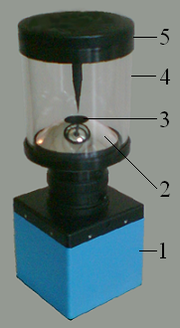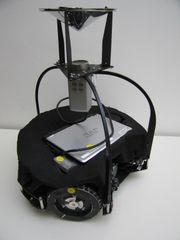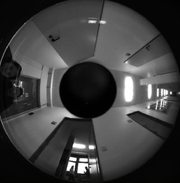
Omnidirectional camera
Encyclopedia

Photography
Photography is the art, science and practice of creating durable images by recording light or other electromagnetic radiation, either electronically by means of an image sensor or chemically by means of a light-sensitive material such as photographic film...
, an omnidirectional camera (from "omni", meaning all) is a camera with a 360-degree field of view
Field of view
The field of view is the extent of the observable world that is seen at any given moment....
in the horizontal plane, or with a visual field that covers (approximately) the entire sphere. Omnidirectional cameras are important in areas where large visual field coverage is needed, such as in panoramic photography and robotics
Robotics
Robotics is the branch of technology that deals with the design, construction, operation, structural disposition, manufacture and application of robots...
.
Overview

Focus (optics)
In geometrical optics, a focus, also called an image point, is the point where light rays originating from a point on the object converge. Although the focus is conceptually a point, physically the focus has a spatial extent, called the blur circle. This non-ideal focusing may be caused by...
through a semi-sphere. In contrast, an ideal omnidirectional camera captures light from all directions falling onto the focal point, covering a full sphere. In practice, however, most omnidirectional cameras cover only almost the full sphere and many cameras which are referred to as omnidirectional cover only approximately a semi-sphere, or the full 360° along the equator of the sphere but excluding the top and bottom of the sphere. In the case that they cover the full sphere, the captured light rays do not intersect exactly in a single focal point.
Panoramic art
Traditional approaches to panoramic photography mainly consists of stitching shots taken separately into a single, continuous image. The stitching of images, however, is computationally intensive (for example using the RANSACRANSAC
RANSAC is an abbreviation for "RANdom SAmple Consensus". It is an iterative method to estimate parameters of a mathematical model from a set of observed data which contains outliers. It is a non-deterministic algorithm in the sense that it produces a reasonable result only with a certain...
iterative algorithm, commonly used to solve the correspondence problem
Correspondence problem
The correspondence problem tries to figure out which parts of an image correspond to which parts of another image, after the camera has moved, time has elapsed, and/or the objects have moved around.-Overview:...
), and depending upon the quality and consistency of the shots used, the resulting image might contain a number of deficiencies which impair the quality of the resulting image. In contrast, an omnidirectional camera can be used to create panoramic art in real time, without the need for post processing, and will typically give much better quality products.
Robotics and computer vision

Visual odometry
In robotics and computer vision, visual odometry is the process of determining the position and orientation of a robot by analyzing the associated camera images...
and to solve the simultaneous localization and mapping
Simultaneous localization and mapping
Simultaneous localization and mapping is a technique used by robots and autonomous vehicles to build up a map within an unknown environment , or to update a map within a known environment , while at the same time keeping track of their current location.- Operational definition :Maps are used...
(SLAM) problems visually. Due to its ability to capture a 360-degree view, better results can be obtained for optical flow
Optical flow
Optical flow or optic flow is the pattern of apparent motion of objects, surfaces, and edges in a visual scene caused by the relative motion between an observer and the scene. The concept of optical flow was first studied in the 1940s and ultimately published by American psychologist James J....
and feature selection and matching.
Miscellaneous

An omnidirectional camera can be implemented in different ways, some of which are described below.

